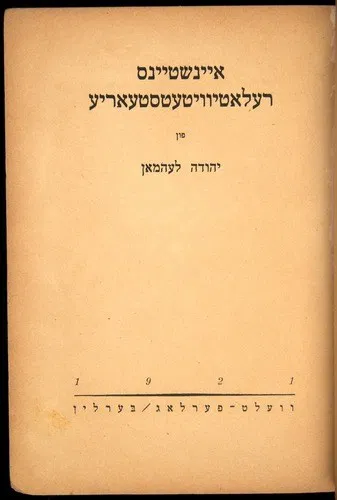Guest post and display by Elizabeth Livesey
In recognition of National Holocaust Remembrance Day this Monday, April 8th, several works will be on display on the 5th floor of Bizzell to commemorate the persecution and genocide of approximately six million Jews.
this Monday, April 8th, several works will be on display on the 5th floor of Bizzell to commemorate the persecution and genocide of approximately six million Jews.
Taken from the History of Science Collections and the Bass Business History Collections, the works showcase only some of the internationally significant contributions made by European scientists of Jewish descent in the early twentieth century, as well as the opposing force of the science of eugenics and the deadly social movement it produced.
Among the pieces on display are those by Nobel Prize winning scientists Niels Bohr, for his discoveries in atomic structure and quantum mechanics, as well as Albert Einstein, via a rare edition of his Theory of Relativity in Yiddish (description).
These books can be viewed at the History of Science Collections on the 5th floor of Bizzell Memorial Library, Monday-Thursday 9 AM -7 PM, Friday 9 AM-5 PM, and Saturday 12-4 PM. For more information, see the Visit link above, or call (405) 325-2741. While there, you may also view the Galileo display and the Living Library exhibition which features more than 100 rare works from the History of Science Collections.
The contributions to science made by Europeans of Jewish backgrounds before and during the Holocaust are remarkable for their breadth and influence even today. Einstein’s and Niels Bohr’s groundbreaking discoveries within the fields of physics won them Nobel Prizes in 1921 and 1922, respectively. Sigmund Freud’s enormously significant work in neurology and psychoanalysis throughout the early 20th century is similarly showcased here through a beautiful allegorical drawing of the unconscious.
enormously significant work in neurology and psychoanalysis throughout the early 20th century is similarly showcased here through a beautiful allegorical drawing of the unconscious.
However, despite the internationally recognized and honored impact that these works hold today, the work of Jewish scientists was not received or appreciated in the same light immediately after Hitler’s rise to power. In contrast to these notable Jewish scientific achievements during this period, the equally pervasive science of eugenics influenced Nazi ideology and undercut these discoveries. One of the most harrowing and ironic cases involves the German-Jewish chemist and 1918 Nobel Prize winner, Fritz Haber , whose work in developing poisonous gases eventually produced the deadly weapon Zyklon
, whose work in developing poisonous gases eventually produced the deadly weapon Zyklon gas. Haber, among the other scientists recognized within this case, was stripped of his position in the university under the Nazis, and his books were burned and denounced in favor of “Aryan” science and achievements.
gas. Haber, among the other scientists recognized within this case, was stripped of his position in the university under the Nazis, and his books were burned and denounced in favor of “Aryan” science and achievements.



